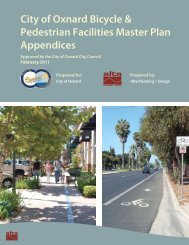Santa Clara River Trail Final Master Plan - Development Services ...
Santa Clara River Trail Final Master Plan - Development Services ...
Santa Clara River Trail Final Master Plan - Development Services ...
You also want an ePaper? Increase the reach of your titles
YUMPU automatically turns print PDFs into web optimized ePapers that Google loves.
<strong>Santa</strong> <strong>Clara</strong> <strong>River</strong> <strong>Trail</strong> <strong>Plan</strong><br />
much of the project site is located on elevated flood control structures generally protected from most<br />
flood flows (City of Oxnard 2008).<br />
The Oxnard Plain Basin, the largest underground water source in the region, has approximately<br />
7,800,000 acre-feet of storage and is mostly confined (covered by an impermeable clay layer). The<br />
confined nature of the basin means that in most areas of the basin rain water or surface water cannot<br />
penetrate the surface of the ground to replenish or recharge the basin. The Oxnard Aquifer, which is a<br />
part of the Oxnard Plain Basin, is currently being overdrafted at a rate of about 12,400 acre-feet per year,<br />
and the overdraft has resulted in more than 22 square miles of the aquifer being intruded upon by<br />
seawater. In the areas of salt water intrusion, the water is no longer suitable for domestic consumption or<br />
agriculture. In addition to salt water intrusion, primary water quality concerns within the Oxnard<br />
<strong>Plan</strong>ning Area also include increasing mineralization and chemical degradation of groundwater. Runoff<br />
from agricultural uses degrades surface and groundwater quality via increased mineral concentrations,<br />
nitrates, and high levels of total dissolved solids (TDS). Additional threats to surface and groundwater<br />
quality include runoff from urban and industrial uses, improperly abandoned water wells and<br />
underground storage tanks. The potential for groundwater contamination is higher in recharge areas<br />
where the clay cap is absent. As of 2006, contaminants that significantly exceed threshold values within<br />
the Oxnard Plain Basin include TDS, nitrate, iron, manganese, chloride and sulfate (Metropolitan Water<br />
District of Southern California 2007).<br />
LAND USE AND PLANNING<br />
The proposed project is within the City of Oxnard and the County of Ventura on land zoned as open<br />
space. The project area is located entirely outside of the Coastal Zone. The <strong>Santa</strong> <strong>Clara</strong> <strong>River</strong> falls within<br />
the jurisdiction of the VCWPD, which operates and maintains the levee and flood control maintenance<br />
road. The VCWPD also implements the Flood Plain Management Ordinance 3841 on behalf of the<br />
County of Ventura to ensure compliance with the National Flood Insurance Program. This includes<br />
permit review for structures built in the floodplain and evaluation of site plans for developments that<br />
include identified floodplains. Additional agencies that may have interest in and permitting authority<br />
over this site include the U.S. Army Corps of Engineers, Ventura Regional Sanitation District, California<br />
Integrated Waste Management Board, Ventura County Local Enforcement Agency, Ventura Regional<br />
Sanitation District, Regional Water Quality Protection Board, U.S. Fish and Wildlife Service, Caltrans,<br />
and the California Department of Fish and Game. The river<br />
is not designated as a Wild and Scenic <strong>River</strong> by the United<br />
States Forestry Service, National Park Service, United<br />
States Fish and Wildlife or Bureau of Land Management.<br />
In the City of Oxnard adjacent land uses to the project<br />
include recreation; low density, low-medium density, and<br />
high density residential; regional commercial, and a school<br />
(City of Oxnard 2009). The City’s General <strong>Plan</strong> recognizes<br />
the importance of bicycle and pedestrian facilities and<br />
identifies the need for their additional development<br />
throughout the City of Oxnard and the surrounding<br />
communities within Ventura County. In response, the City<br />
The proximity of trains and roads, the<br />
primary noise generators in the vicinity<br />
of the project, can degrade sensitive<br />
habitats and recreation.<br />
City of Oxnard | 9
















